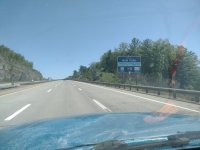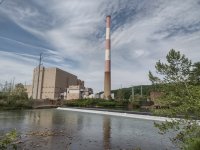- Joined
- Aug 10, 2018
- Messages
- 1,731
- Reaction score
- 2,609
"If you want to hear God laugh, tell him your plans."
Pre-trip Trip:
I spent much of the winter searching out some local canoe tripping possibilities and found a seemingly nice prospect in the Little Muskingum River in Ohio. I researched drift speed at various water levels and camping opportunities, found an outfitter in Marietta, Ohio who was willing to shuttle me 60 miles upstream and even made tentative plans to paddle it as a non-solo trip when Tony from OCHRA indicated that he might like to tag along.
In my estimation, it would be a great test paddle for the strip canoe that I would build over the winter and an opportunity to make sure I had the right boat for my trip to Ontario this coming summer... Yep, everything was going my way... and then reality creeped in.
Memorial day rolled around and the boat was not built, spring had been very dry and the water level on the Bloomfield gauge was at 2.75 feet when minimum of 4 (max of 6) is recommended. I would not be paddling anything through that rock garden much less a boat that wasn't even built.

I did, however, find a good deal on a solo canoe that I found intriguing so I decided that this Memorial Day would involve a canoe trip of another kind... a road trip.
Early Friday morning I fired up the rusty, trusty Ranger, filled a thermos with coffee and headed toward Geneva, NY.


About 3 1/2 hrs into the 5 hour ride, I stopped for gas and noticed that the rear of the truck was sitting crooked... One of the spring hangers had rusted out and collapsed. It looked like the end of the spring was pretty securely wedged into what was left of the mount and I figured AAA would cover towing with or without a canoe on top so I proceeded north where I examined and purchased a Sawyer Summersong which was really in very nice shape for its age with barely a scratch.
A very flat keeled solo canoe, I asked the seller about using it in moving water and he assured me that, while it's a very fast, straight tracking flat water boat, there was no way it should be used on a river as it doesn't turn worth crap at speed.
My planned trip into Ontario this summer does include some river travel but appears to be mostly lake paddling, the price seemed reasonable and I'd already driven 5 hours to see it... I paid the man, loaded the boat and headed home.
The ride back was uneventful and the front of the spring remained wedged somewhat securely into the wreckage of the mount although I stopped pretty frequently to look for movement, avoided highways so I would be moving more slowly when it inevitably broke loose and, of course, I cringed with every bump I hit (if you've ever driven the southern tier of New York or anywhere in PA, you'll know the ride was one continuous cringe).
About 12 hours after leaving home and some 400 miles after noticing the broken mount, the Ranger, the Summersong and I made it safely home. (There's a very good reason that I'm fond of that truck)
Pre-trip Trip:
I spent much of the winter searching out some local canoe tripping possibilities and found a seemingly nice prospect in the Little Muskingum River in Ohio. I researched drift speed at various water levels and camping opportunities, found an outfitter in Marietta, Ohio who was willing to shuttle me 60 miles upstream and even made tentative plans to paddle it as a non-solo trip when Tony from OCHRA indicated that he might like to tag along.
In my estimation, it would be a great test paddle for the strip canoe that I would build over the winter and an opportunity to make sure I had the right boat for my trip to Ontario this coming summer... Yep, everything was going my way... and then reality creeped in.
Memorial day rolled around and the boat was not built, spring had been very dry and the water level on the Bloomfield gauge was at 2.75 feet when minimum of 4 (max of 6) is recommended. I would not be paddling anything through that rock garden much less a boat that wasn't even built.

I did, however, find a good deal on a solo canoe that I found intriguing so I decided that this Memorial Day would involve a canoe trip of another kind... a road trip.
Early Friday morning I fired up the rusty, trusty Ranger, filled a thermos with coffee and headed toward Geneva, NY.


About 3 1/2 hrs into the 5 hour ride, I stopped for gas and noticed that the rear of the truck was sitting crooked... One of the spring hangers had rusted out and collapsed. It looked like the end of the spring was pretty securely wedged into what was left of the mount and I figured AAA would cover towing with or without a canoe on top so I proceeded north where I examined and purchased a Sawyer Summersong which was really in very nice shape for its age with barely a scratch.
A very flat keeled solo canoe, I asked the seller about using it in moving water and he assured me that, while it's a very fast, straight tracking flat water boat, there was no way it should be used on a river as it doesn't turn worth crap at speed.
My planned trip into Ontario this summer does include some river travel but appears to be mostly lake paddling, the price seemed reasonable and I'd already driven 5 hours to see it... I paid the man, loaded the boat and headed home.
The ride back was uneventful and the front of the spring remained wedged somewhat securely into the wreckage of the mount although I stopped pretty frequently to look for movement, avoided highways so I would be moving more slowly when it inevitably broke loose and, of course, I cringed with every bump I hit (if you've ever driven the southern tier of New York or anywhere in PA, you'll know the ride was one continuous cringe).
About 12 hours after leaving home and some 400 miles after noticing the broken mount, the Ranger, the Summersong and I made it safely home. (There's a very good reason that I'm fond of that truck)


































